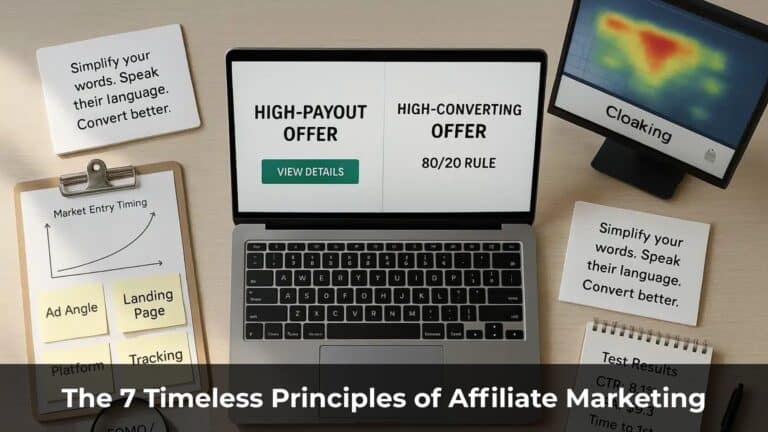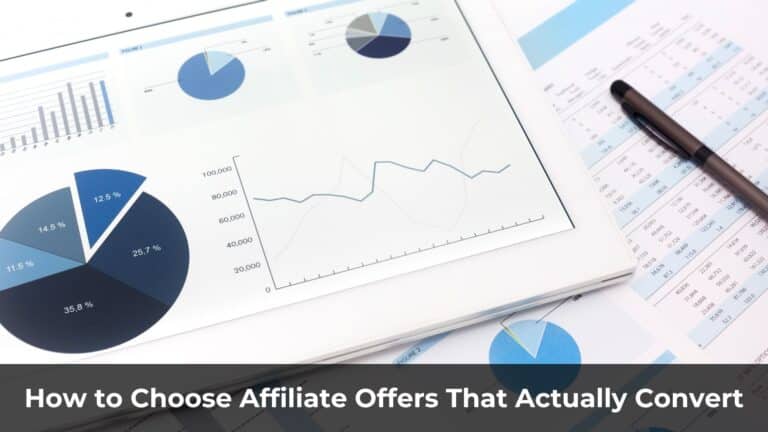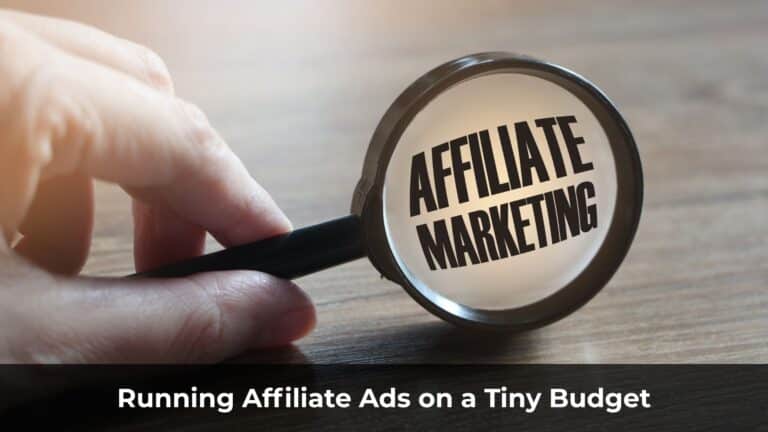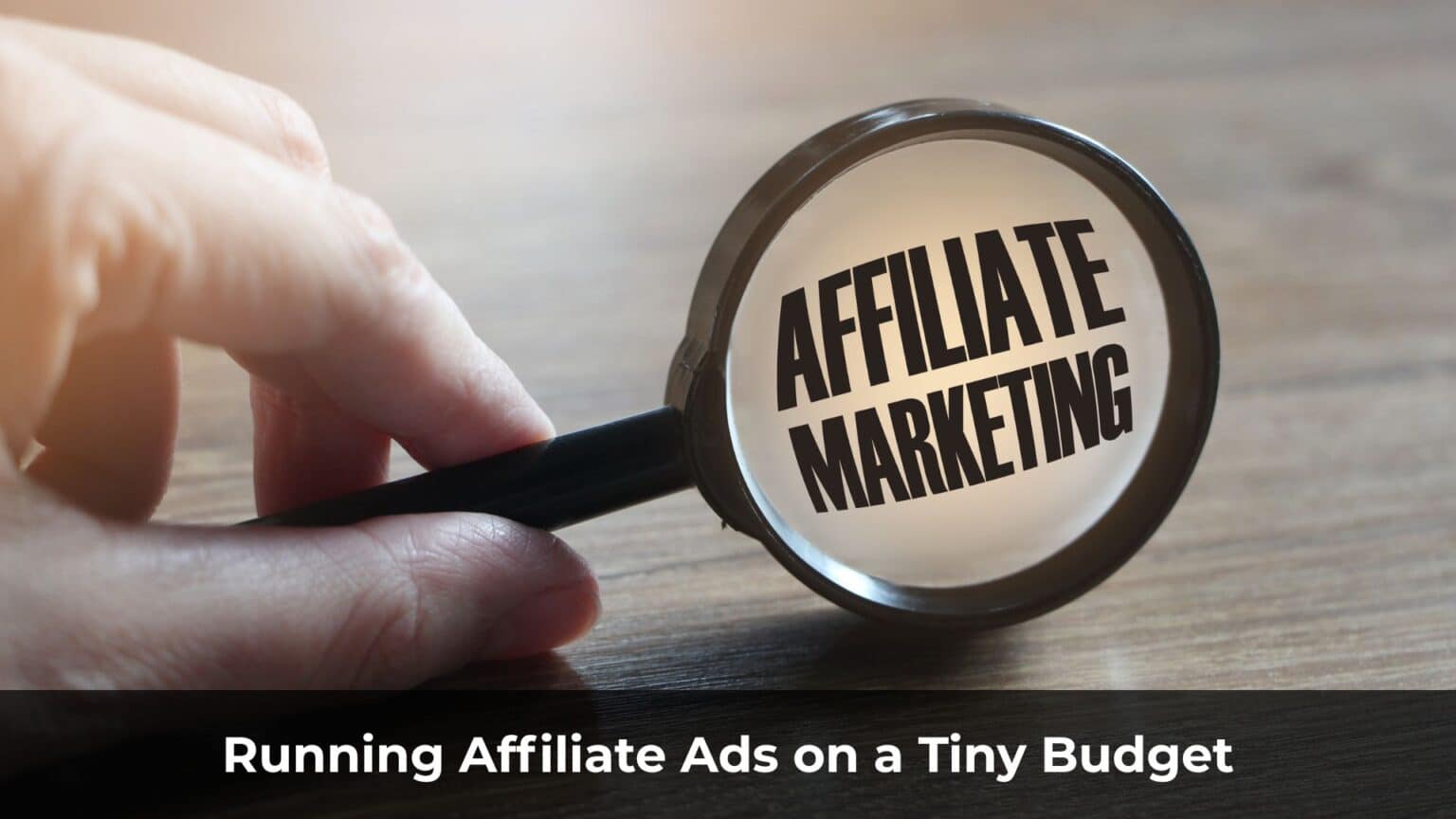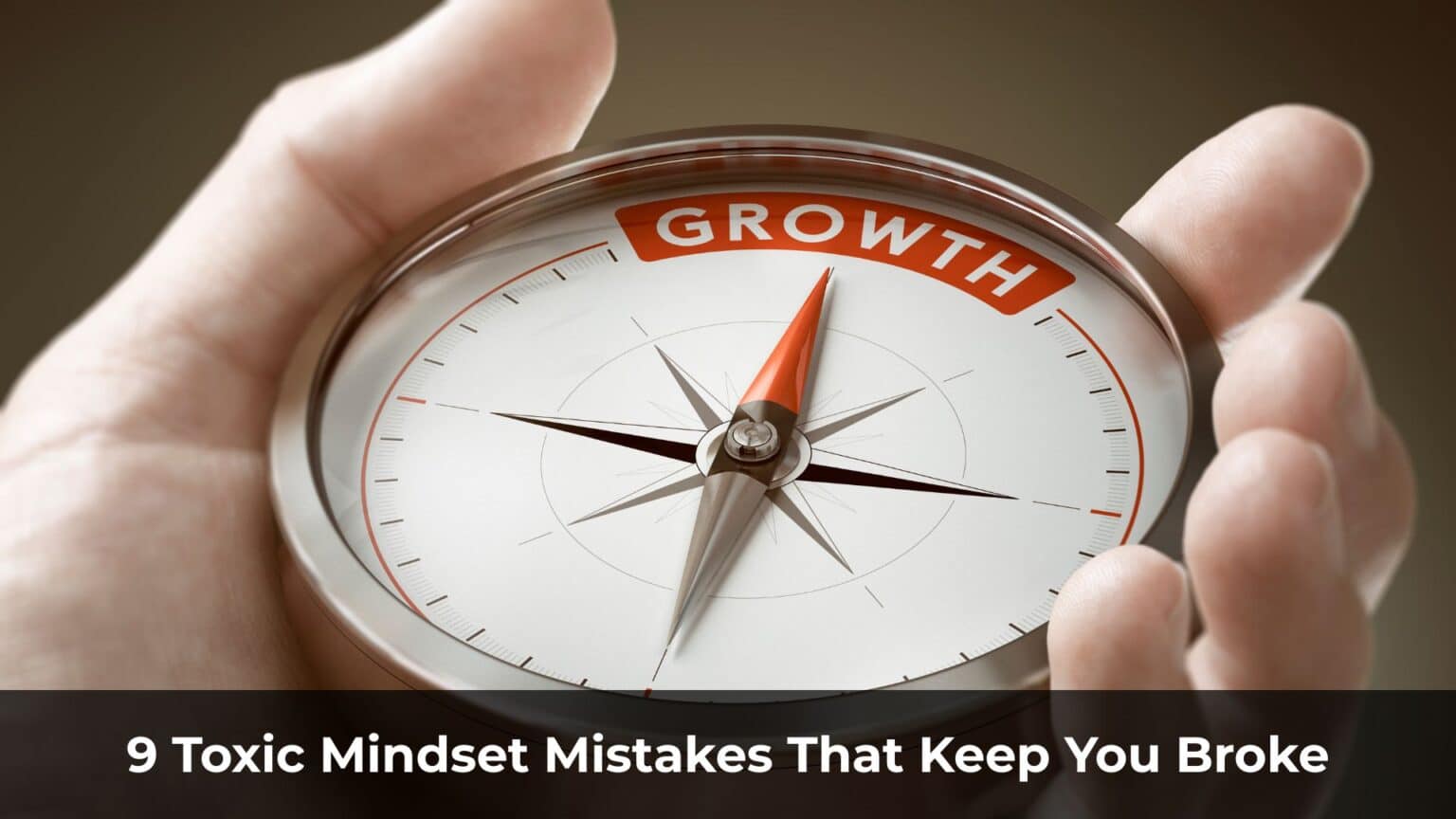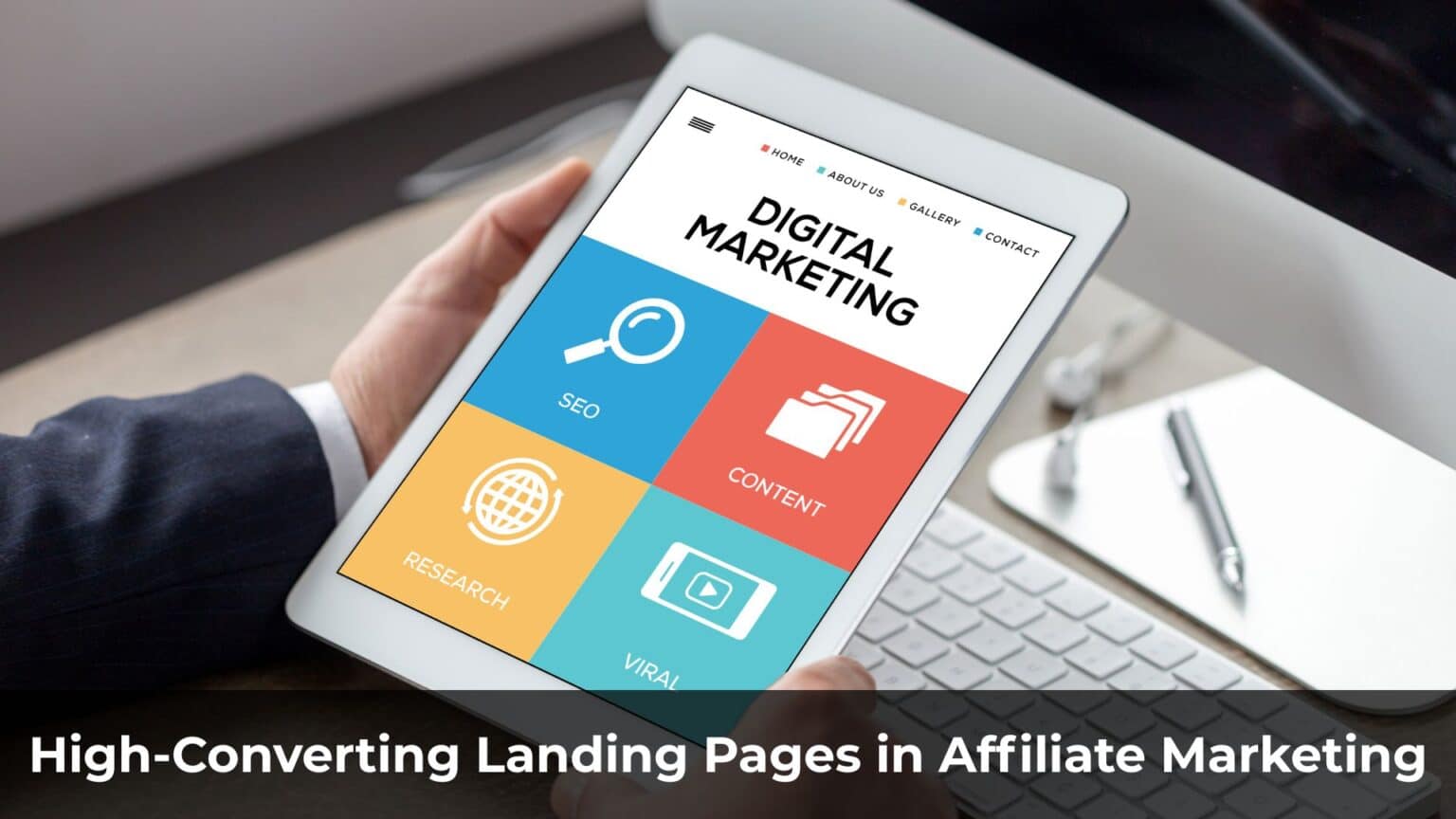At the heart of every affiliate marketing campaign lies one simple goal: conversion.
To convert, you need compelling ads. And at the core of every compelling ad is a powerful angle.
An angle is the perspective you take—the way you frame the story, spark desire, highlight pain points, or tap into your audience’s fears and aspirations.
A strong angle can turn an average offer into a high-ROI campaign. A weak one? It can burn through your budget with little to show for it.
In this guide, you’ll learn how to build a repeatable system for generating winning angles.
I’ll walk you through the exact process of researching, creating, testing, and scaling angles—so you’re not just throwing spaghetti at the wall, but building campaigns with purpose and precision.
Table of Contents
ToggleWhy You Need an Angle-Building System
A single ad can work wonders… for a while. Maybe a few days, maybe a few weeks. But eventually, performance drops.
Why? Because people have seen it too many times. The excitement fades. Clicks slow down. And if you don’t have something fresh to replace it, your campaign stalls.
So what do you do when your campaign hits a wall?
You need to keep innovating—new creatives, new landing pages, and most importantly, new ways to approach your audience.
But let’s be real: coming up with fresh ad ideas is hard. Many marketers sit there staring at a blank screen, hoping for inspiration… and getting nowhere.
The problem? They don’t have a system.
No structure. No repeatable process. Every time they need a new ad, they’re starting from scratch—guessing, hoping, improvising.
I’ve seen countless affiliates run the same landing page for an entire year. Dozens of others copy it, change the headline, swap out the image—and pray it converts.
That kind of approach won’t get you far.
What you need is a structured angle system—a method to:
- Analyze your niche with clarity
- Quickly generate ad ideas that make sense
- Develop new angles consistently, not just when “inspiration strikes”
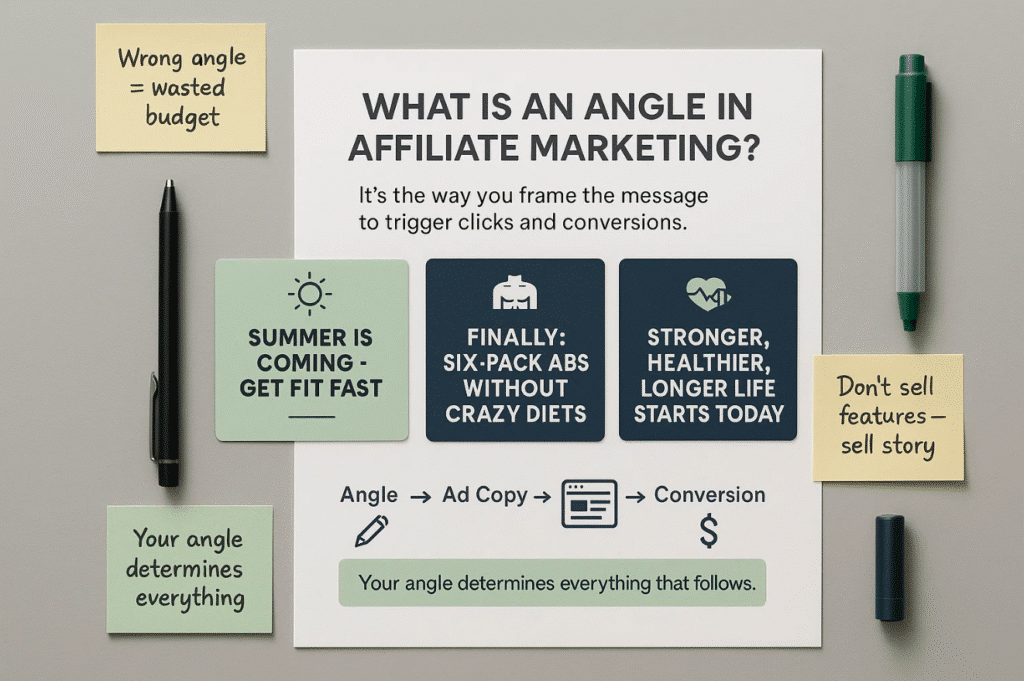
What Are Angles in Affiliate Marketing (and Why They Matter)?
An angle is your strategic entry point—the way you frame a problem, spark curiosity, or present a scenario that gets people to stop scrolling, click, and eventually convert.
The product stays the same. But change the angle, and your results can shift dramatically.
Take a gym membership, for example. There are countless ways to angle it:
- Seasonal angle: “Get summer-ready—shed the weight, feel the heat.”
- Appearance angle: “Six-pack abs? It’s no longer just a dream.”
- Health angle: “Train for longevity—stay strong, live longer.”
Each of these angles leads to a different ad, a different landing page, and a completely different tone in your messaging.
That’s why angle is the foundation of any campaign. If you get the angle wrong, everything else—your creatives, copy, and targeting—can easily go off track.
Mini Angles in Affiliate Marketing: What They Are and How to Use Them
A mini angle is a more focused extension of a broader campaign angle.
Think of your main angle as the strategic direction—and mini angles as the tactical zoom-ins. They help you speak to specific situations, niches, or audience segments with greater precision.
Let’s revisit the gym membership example.
Suppose your main angle is:
“Work out to improve your appearance—get back in shape.”
It’s a solid message. It appeals to a broad, relatable desire. But if you want to drive higher conversions, you need to make it personal. That’s where mini angles shine.
From that one main idea, you can create multiple mini angles like:
- “Fit back into your old wedding dress—without starving yourself”
- “Regain your abs after two years at a desk job”
- “Feel confident at the beach—no more covering up”
- “Just 3 workouts a week to tone up before the holidays”
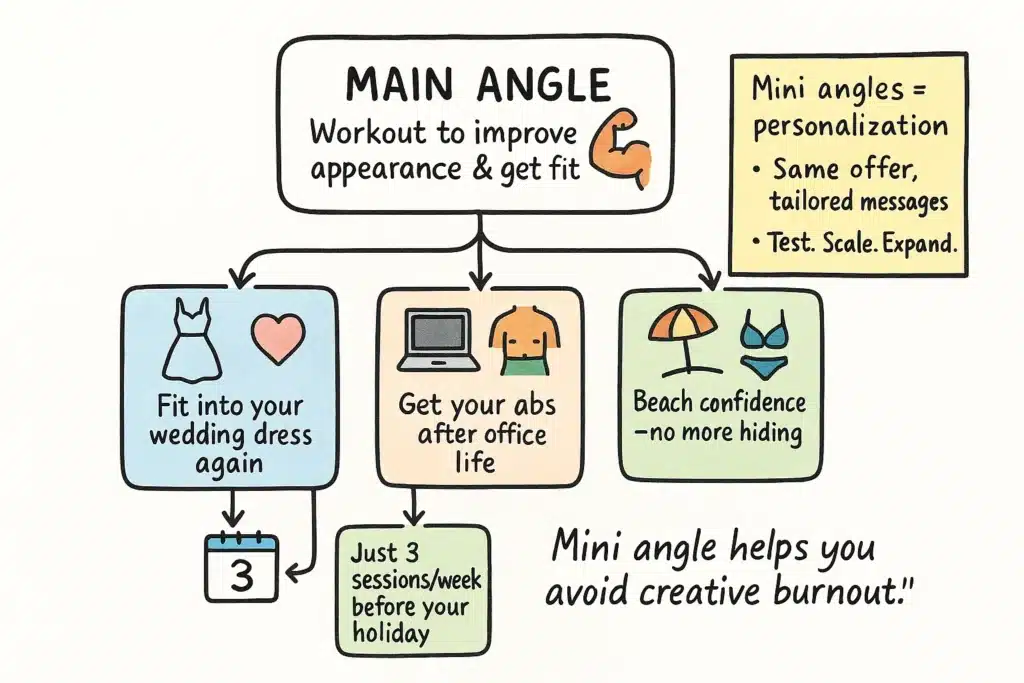
Each mini angle speaks directly to a different subgroup—same offer, but a more tailored message that hits closer to home.
Mini angles are especially useful when:
- Your main angle is already working, and you want to scale
- You’re testing different ad creatives or hooks
- You’re expanding to new audience segments
Understanding how to develop and use mini angles helps you avoid the dreaded “creative block.” Instead of running out of ideas, you’ll have a flexible, long-lasting campaign system that evolves with your audience.
Building a Scalable System for Generating Angles
Now that you understand the concept of angles and mini angles, it’s time to build something repeatable—a system you can scale.
Having a structured angle-generation system saves you time every time you need new ad creatives. More importantly, it helps your campaigns run longer, scale more smoothly, and reduce risk when managing larger budgets.
A solid system is built around three core pillars:
- Choosing the right niche and identifying your audience’s real problems
- Creating angle clusters based on insights and emotional triggers
- Breaking them down into mini angles for testing and personalization
Let’s begin with step one: niche research in affiliate marketing.

Researching Your Niche and Analyzing Existing Angles
Once you’ve picked a niche that’s specific enough, the next step is market research—looking at what angles are currently being used, and how well they’re performing.
This isn’t about copying someone else’s ad word for word.
The goal is to understand:
- How the market is currently communicating with the audience
- Which fears, desires, or emotions are being triggered
- Where there’s room to improve—or take a completely different direction
Tools you can use for angle research:
- AdSpy (focused on Facebook): Lets you search ads by keyword, affiliate network, or even by landing page domain.
- Adplexity (for native, desktop, and YouTube ads): Gives you full visibility into headlines, creatives, and even the landing pages your competitors are using.
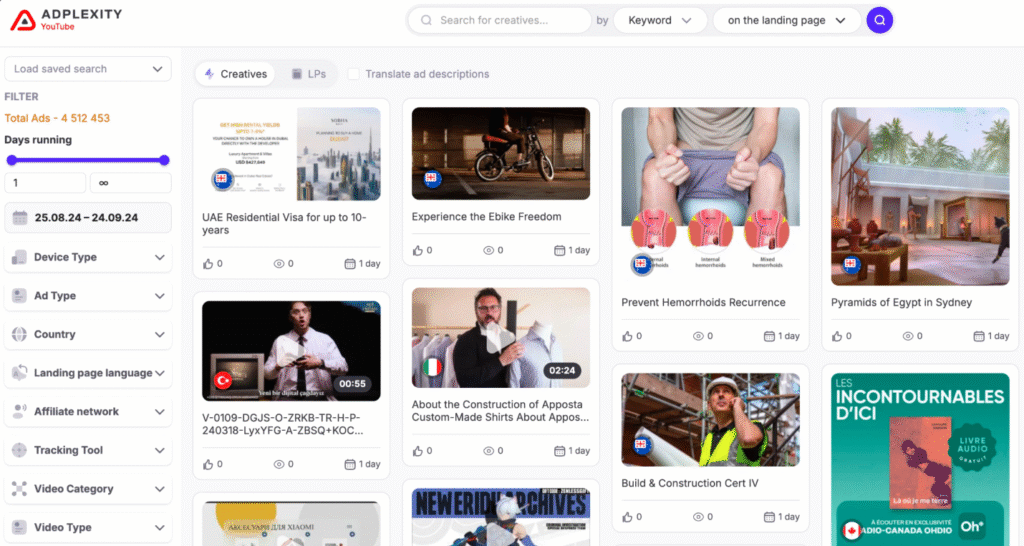
When analyzing ads, don’t just look at slick visuals or catchy headlines. Ask deeper questions:
- What’s the angle behind this ad?
- Which emotion is it tapping into—fear, pride, hope, frustration?
- Who is the target audience for this message?
For example:
In the home insurance niche, you might find ads showing a house destroyed by a hurricane—or footage of a break-in during the night.
Clearly, those ads are playing on the fear of loss—specifically, natural disasters and burglary.
You can take note of angles like these, categorize them by theme, and use them as inspiration to develop your own system.
Think of this as a starting point—not the final answer.
From here, your goal is to create better, more original angles that stand out in the marketplace.
Organizing Angles Into a Strategic System
Once you’ve done your angle research, the next step is to start generating angles tailored to your niche. But don’t just jot down random ideas—do it with structure.
A true angle system means categorizing your ideas based on goals, emotions, and life situations. This gives your campaign a clear direction, and makes testing faster, smarter, and more manageable.
One proven framework is to group angles across three core pillars:
- Desire – What does your audience want to achieve?
- Fear – What are they afraid might happen?
- Change – What transition or life stage are they going through?
Let’s say you’re promoting a language learning app for older adults. Here’s how that could break down:
Desire-based angles:
– Wanting to speak basic phrases while traveling abroad
– Keeping the mind sharp and mentally active
Fear-based angles:
– Feeling lost or helpless in a foreign country
– Worrying about memory decline with age
– Fear of being judged: “Too old to be learning”
Change-based angles:
– Just retired and finally have free time
– Recently joined a senior social group, looking to connect more
From these three pillars, you can craft both broad angles and highly targeted mini angles—each tailored to a real scenario, instead of using a generic message like: “Anyone can learn a new language!”
Take your time. Ask the right questions. Write down real answers.
That’s how you create ad messaging that actually resonates.
Think of this process like building a content library. Each angle gets its own folder—ready to be pulled out, refined, and used whenever you need it.

Real-World Example: Deploying Angles and Mini Angles in Affiliate Campaigns
Let’s say you’re running an affiliate campaign for a personal finance investment course. It’s a broad offer with multiple potential audiences: young professionals, parents, even people nearing retirement.
But if you just throw out one generic ad, your conversion rate will likely tank.
So how do you approach this strategically?
Start by defining a main angle. For example:
“Learn how to manage your money and achieve financial freedom in 5 years.”
From there, you build supporting angle clusters tailored to different life stages and concerns:
- Young professionals → “Start saving and investing from your very first paycheck”
- Expecting parents → “Build a rock-solid financial plan for your growing family”
- Debt-stressed individuals → “Escape the debt cycle with this 3-step money strategy”
Each of these can lead to a dedicated ad headline, a unique video creative, and even a custom landing page—all branching out from one core message.
But you can go even deeper by creating mini angles within each group.
For example:
Main Angle: Young adults who want to start investing
→ Mini angle 1: “You don’t need $5,000—start investing with just $40/month”
→ Mini angle 2: “Investing made simple for complete beginners”
→ Mini angle 3: “Turn your e-wallet into a smart savings machine”
Each mini angle tackles a highly specific pain point or mental roadblock. This personalization helps your message land harder—and convert better.
And here’s the best part:
When one mini angle gets saturated, you don’t need to reinvent the wheel. You simply pivot to another mini angle under the same umbrella.
This is how you build a flexible, scalable angle system—without breaking your campaign every time performance dips.

Using Mini Angles to Deepen Your Affiliate Campaigns
Mini angles are a powerful way to drill down into specific user segments, situations, and emotional triggers.
Instead of creating one generic ad for “young professionals,” you can break that audience into smaller, sharper subgroups:
- Low-income earners → “Build savings with just $2 a day”
- Tech-savvy users → “Automated investing—no market tracking needed”
- Risk-averse beginners → “Safe investment strategies for first-timers”
Each mini angle promotes the same offer, possibly even the same landing page—but the message and approach are completely different.
When you have a strong list of mini angles, you’re never stuck. You can test multiple variations—and pivot fast when one direction starts to burn out.
Example:
Let’s say your campaign has been doing well with the mini angle:
“Start investing with just $40/month.”
But after a few weeks, the click-through rate begins to drop.
Instead of pausing the campaign, you pivot to:
“Use an app to automate your investments.”
You update the headline, tweak the creative, shift the message—and suddenly the same campaign has new life for another few weeks.
That’s the strength of a mini angle strategy: agility, speed, and staying power.
From Idea to Execution: Building a Real-World Angle System
Angles require creativity.
But if you rely on inspiration alone, you’ll find yourself overthinking every time you need to launch a new campaign.
So how do you move faster?
Is it possible to come up with ad ideas in 5 minutes—instead of wasting hours staring at a blank page?
The answer is yes.
You just need a system that helps you generate angles quickly and consistently.
Here’s a 4-step process to systematize your angle creation—from initial concept to real-world deployment.
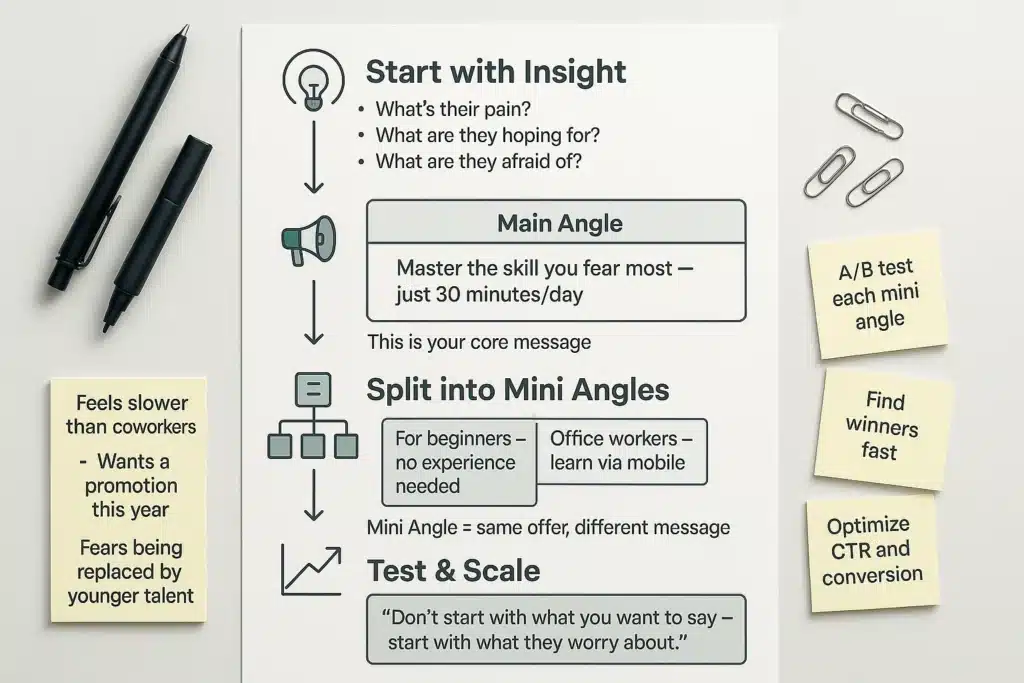
Step 1: Start With User Insight
Every high-converting angle starts with one thing:
Understanding what your audience is thinking, feeling, and striving for.
Insight doesn’t have to be complicated.
Just answer these three questions:
- What problem are they currently facing?
- What are they actively searching for?
- What are they afraid might happen if they don’t solve it soon?
Example:
If you’re promoting a course on professional skills, your audience might:
- Feel like they’re falling behind their coworkers
- Want to earn a promotion this year
- Fear being replaced by younger, more capable hires
The deeper your understanding of your audience, the sharper your angle will be.
Don’t start with “What do I want to say?”
Start with “What’s keeping my audience up at night?”
Step 2: Create a Core Angle, Then Break It Into Mini Angles
Once you’ve uncovered the user insight, it’s time to craft your core angle—the main message of your campaign. This is the big idea, the central hook that speaks directly to your audience’s pain point or desire.
Example:
If you’re promoting an online course, your core angle might be:
“Master the skill you’ve always avoided—in just 30 minutes a day.”
From there, you can branch out into mini angles tailored to specific segments or situations:
- “Perfect for beginners—no prior knowledge required”
- “Made for busy office workers—learn on your phone during breaks”
- “Accelerated learning to help you apply for a new job in 30 days”
Mini angles allow you to keep the offer the same, but personalize the message.
This step is crucial for boosting click-through rates, lowering ad costs, and improving conversion rates—without reinventing the campaign.
Step 3: Translate Your Angle Into Concrete Content
Even the best angle is worthless if it’s not executed properly.
At this stage, you’ll turn your main angle and mini angles into specific content elements for your campaign:
- Ad headlines
- Supporting visuals or videos
- Ad copy or video scripts
- Landing page structure and content
Each angle should come with a complete content package. That way, when you run tests, you can clearly identify what’s working—or what’s holding the campaign back.
Is it the angle?
The image?
Or maybe the landing page needs improvement?
Example:
For the mini angle “designed for busy people”:
- Headline: “Learn a new skill in just 15 minutes a day”
- Image: A person learning on their phone while waiting at a bus stop
- Copy: Minimal, highlighting flexibility and ease
- Landing page: Quick to navigate, minimal form fields
Keeping everything aligned with the core angle ensures your A/B tests stay meaningful.
Without that consistency, a great angle might get unfairly judged—just because the visual was off or the message wasn’t clear.
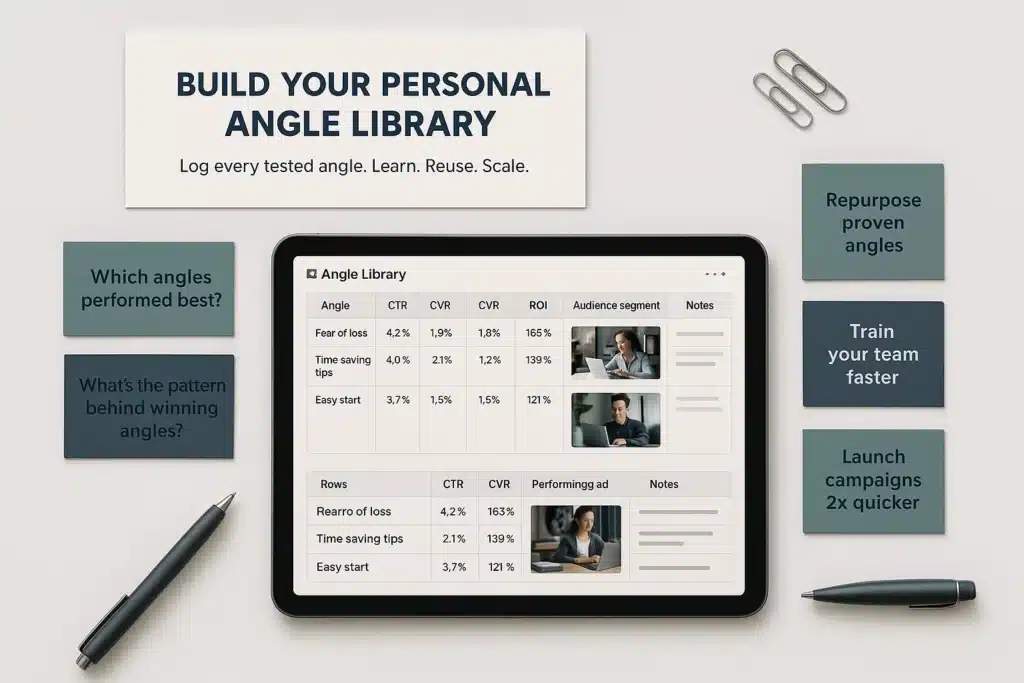
Step 4: Track Results and Build Your Personal Angle Library
Once you’ve launched your campaign and tested a few angles, don’t just glance at the results and move on.
This is when you start building your long-term system.
Start recording:
- Which angles are performing best
- Their corresponding CTR, CVR, and ROI
- Which audience segments respond well to each angle
- Which creatives (images, videos, copy) drive the best results
- Patterns or common traits among high-performing angles
Document everything in a structured spreadsheet—using tools like Google Sheets, Notion, or Airtable.
Each row should represent one angle, and can include supporting materials like:
- Ad headline
- Sample creative
- Landing page variant
- Performance data from your tests
Over time, you’ll develop your own personal angle library—a strategic asset you can reuse, scale, and improve.
This database gives you a creative edge. It helps you:
- Recycle proven angles faster
- Train new team members with real-world data
- Plan future campaigns with clarity
- Scale your campaigns with control, not chaos
Scaling Campaigns with an Angle-Based System
Once you’ve built a proven angle library, scaling your campaigns is no longer a guessing game—it becomes a strategic, repeatable process.
Scaling isn’t just about throwing more money at a single ad.
It means you’re able to:
- Maintain performance as you increase budget
- Expand into new audience segments
- Extend the campaign lifespan without conversion drop-off
And you do it all through your angle system.
Example:
Let’s say you have a high-performing mini angle:
“Busy professionals who want to learn new skills.”
But after a few weeks, performance starts to fade.
Competitors are copying your ad, and your audience is becoming numb to the message.
Instead of forcing it to keep running, you pivot to a different mini angle under the same core idea:
- “People looking to switch careers”
- “Those aiming for a salary raise”
- “Employees feeling left behind by more ambitious coworkers”
By rotating angles, you refresh your campaign—without changing the offer, landing page, or rebuilding everything from scratch.
You can also scale horizontally:
- Use a different angle to reach women instead of just men
- Adapt your message for an older demographic (e.g., 35+ instead of 25–34)
With an angle system, you’re no longer scaling blindly.
You know which angles have room to grow, which ones to retire, and you always have backups ready when performance starts to dip.
Final Thoughts: Why Systems Win in Affiliate Marketing
There’s a quote from Jim Collins that says:
“The greatest danger is not failure—it’s success without understanding why you succeeded.”
In affiliate marketing, many people stumble into a winning campaign by luck.
But when they try to repeat that success, nothing works.
Why?
Because they had no system.
They couldn’t explain what made it work in the first place.
Now contrast that with a marketer who has a complete angle-generation system—from insight discovery to core angle creation, mini angle development, structured testing, and performance tracking.
That person can:
- Create new angles on demand
- Analyze exactly why something worked (or didn’t)
- Reuse proven strategies without reinventing the wheel
This isn’t just a smarter way to run campaigns.
It’s the foundation of a long-term business—one that doesn’t rely on trends, luck, or flashes of inspiration.
Campaigns will end.
Offers will get pulled.
But if you have a system to consistently generate and refine angles, you’ll always have the upper hand.
Want to build your own angle system? Start by documenting 3 winning ads you’ve seen this week—and ask: what angle are they using?

